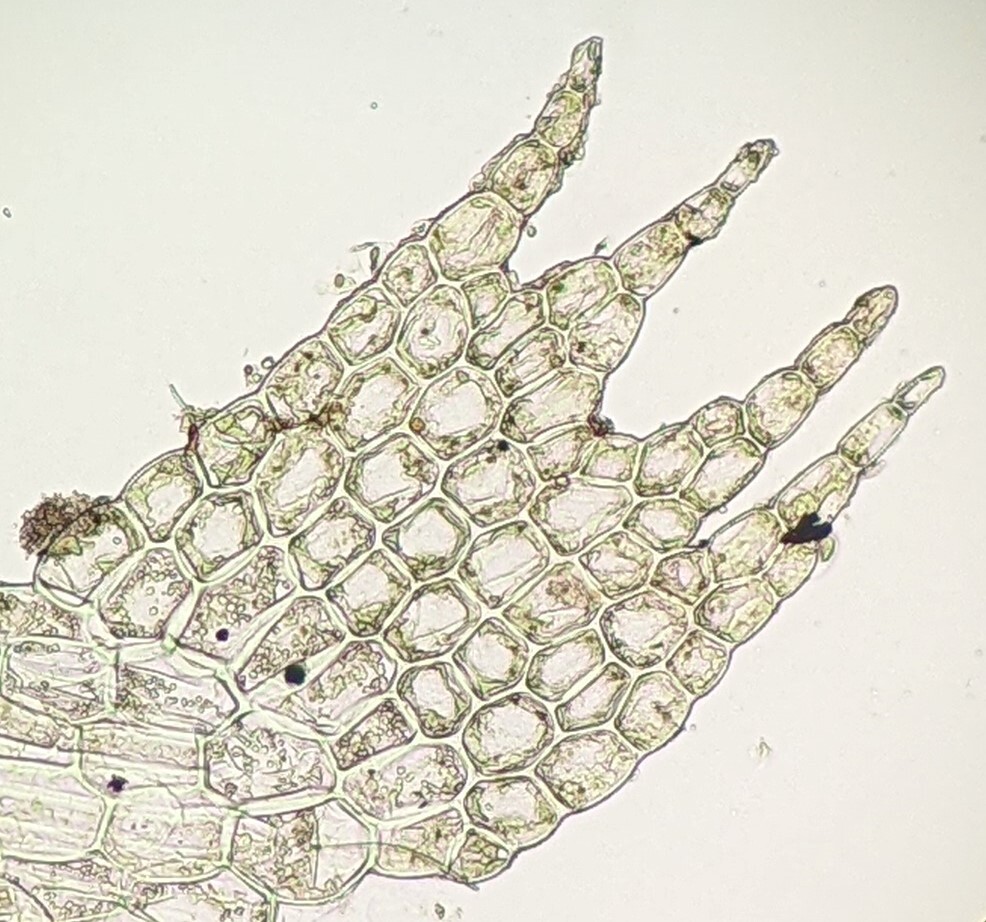Ceramanus
Terrestrial, dioicous. Asexual reproduction by fragmenting leaf lobe tips, rarely by tubers at apices of stems with reduced leaves (not in Victoria). Stems prostrate, 1–3-pinnate, with two ranks of lateral leaves and a single rank of underleaves, sometimes with stems with reduced leaves; branches arising from stems near abaxial side of lateral leaf with fewer lobes and without a collar of tissue at base or from near an unmodified underleaf and with a collar of tissue at base, rarely from beside an underleaf with fewer lobes and without a collar of tissue at base (not in Victoria). Lateral leaves quadrate to rectangular or rarely obtrapezoid (not in Victoria) in outline, mostly 3–4-lobed, rarely 5–7-lobed, symmetric to asymmetric, incubous to almost longitudinally inserted, spreading horizontally and perpendicular to stem or branch or angled toward apex, distant to imbricate, entire, collectively pale green or glaucous and water repellent, unistratose; lobes equal, caudate and uniseriate for most of length, up to half length of leaf, parallel with disc margins, acute. Underleaves much smaller than lateral leaves, 3–4 (–6)-lobed, spreading, distant; lobes a single series of cells, terminated by a slime papilla. Leaf cells polygonal to quadrate or oblong, sometimes becoming distinctly more elongate in lobes, smooth or finely granular, thin- (not in Victoria) to thick-walled, without distinct trigones, with 3–6 botryoidal oil bodies. Rhizoids fascicled from underleaf disc. Androecia on short branches with a few normal leaves basal to ventricose bracts or on short branches arising from ventral stem with only ventricose bracts, each with a single antheridium. Sporophyte terminating short branch emerging from ventral side of stem, without normal vegetative leaves but subtended by highly differentiated bracts and developing within a perianth; bracts 4–6 lobed or ciliate-lobulate; perianth obovoid, cylindric or fusiform, terete at base, becoming trigonous and plicate toward mouth where unlobed to lobulate and denticulate to ciliate; capsule ellipsoid, tristratose; elaters bispiral; spores areolate, yellow-brown.
Seven species, three in New Zealand, one in Fiji, one in south-west Western Australia and two in south-east Australia, one, C. centipes (Lindenb. & Gottsche) E.D.Cooper, of which is in Victoria (Engel & Smith Merrill 2004; Cooper et al. 2013).
Ceramanus forms one of the three lineages previously included in Telaranea, that were shown in phylogenies of DNA regions from nucleus, mitochondrion and chloroplast to be closely related to Lepidozia, but not to Telaranea (Cooper et al. 2011, 2012).
Cooper, E.D., Shaw, A.J., Shaw, B., Henwood, M.J., Heslewood, M.M. & Brown, E.A. (2011). A multi-locus molecular phylogeny of the Lepidoziaceae: Laying the foundations for a stable classification. Molecular Phylogenetics and Evolution 59: 489–509.
Cooper, E.D., Henwood, M.J. & Brown, E.A. (2012). A molecular phylogeny of the Lepidozia generic complex supports re-circumscription of the Lepidozioideae. Molecular Phylogenetics and Evolution 65: 10–22.
Cooper, E.D., Söderström, L., Hagborg, A. & von Konrat, M. (2013). Notes on early land plants today. 38. New combinations and synonyms in Lepidoziaceae (Marchantiophyta). Phytotaxa 97: 52–62.
Engel, J.J. & Smith Merrill, G.L. (2004). Austral Hepaticae. 35. A taxonomic and phylogenetic study of Telaranea (Lepidoziaceae), with a monograph of the genus in temperate Australasia and commentary on extra-Australasian taxa. Fieldiana, Botany 44: 1–261.
 Spinning
Spinning